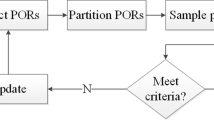Abstract
The uniform design proposed by Fang [6] and Wang and Fang [17] has become an important class of designs for both traditional industrial experiments and modern computer experiments. There exist established theory and methods for constructing uniform designs on hypercube domains, while the uniform design construction on arbitrary domains remains a challenging problem. In this paper, we propose a deterministic construction method through inverse Rosenblatt transformation, as a general approach to convert the uniformly designed points from the unit hypercubes to arbitrary domains. To evaluate the constructed designs, we employ the central composite discrepancy as a uniformity measure suitable for irregular domains. The proposed method is demonstrated with a class of flexible regions, constrained and manifold domains, and the geographical domain with very irregular boundary. The new construction results are shown competitive to traditional stochastic representation and acceptance-rejection methods.
Access this chapter
Tax calculation will be finalised at checkout
Purchases are for personal use only
Similar content being viewed by others
References
Arnold, B.C., Castillo, E., Sarabia, J.M.: Families of multivariate distributions involving the Rosenblatt construction. J. Am. Stat. Assoc. 101(476), 1652–1662 (2006)
Borkowski, J.J., Piepel, G.F.: Uniform designs for highly constrained mixture experiments. J. Qual. Technol. 41, 35–47 (2009)
Chen, R.B., Shu, Y.H., Hung, Y., Wang, W.: Central composite discrepancy-based uniform designs for irregular experimental regions. Comput. Stat. Data Anal. 72, 282–297 (2014)
Chen, R.B., Li, C.H., Hung, Y., Wang, W.: Optimal noncollapsing space-filling designs for irregular experimental regions. J. Comput. Graph. Stat. 28(1), 74–91 (2019)
Chuang, S.C., Hung, Y.: Uniform design over general input domains with applications to target region estimation in computer experiments. Comput. Stat. Data Anal. 54, 219–232 (2010)
Fang, K.T.: The uniform design: application of number theoretic methods in experimental design. Acta Math. Appl. Sin. 3, 363–372 (1980)
Fang, K.T., Li, R.Z., Sudjianto, A.: Design and Modeling for Computer Experiments. Chapman and Hall/CRC, Boca Raton, FL (2006)
Fang, K.T., Liu, M.Q., Qin, H. and Zhou, Y.D.: Theory and Application of Uniform Experimental Designs. Springer, Singapore (2018)
Fang, K.T., Wang, Y.: Number-Theoretic Methods in Statistics. Chapman and Hall, London (1994)
Fang, K.T., Yang, Z.H.: On uniform design of experiments with restricted mixtures and generation of uniform distribution on some domains. Stat. Probab. Lett. 46, 113–120 (2000)
Hickernell, F.: A generalized discrepancy and quadrature error bound. Math. Comput. 67(221), 299–322 (1998)
Justel, A., Pena, D., Zamar, R.: A multivariate Kolmogorov-Smirnov test of goodness of fit. Stat. Probab. Lett. 35(3), 251–259 (1997)
Lin, D.K.J., Sharpe, C., Winker, P.: Optimized \(U\)-type designs on flexible regions. Comput. Stat. Data Anal. 54, 1505–1515 (2010)
Niederreiter, H.: Random Number Generation and Quasi-Monte Carlo Methods. SIAM, Philadelphia (1992)
Rosenblatt, M.: Remarks on a multivariate transformation. Ann. Math. Stat. 29, 470–472 (1952)
Tian, G.L., Fang, H.B., Tan, M., Qin, H., Tang, M.L.: Uniform distributions in a class of convex polyhedrons with applications to drug combination studies. J. Multivar. Anal. 100, 1854–1865 (2009)
Wang, Y., Fang, K.T.: A note on uniform distribution and experimental design. Kexue Tongbao 26, 485–489 (1981)
Zaremba, S.K.: Good lattice points, discrepancy, and numerical integration. Annali di matematica pura ed applicata 73(1), 293–317 (1966)
Zhang, R.C.: On a transformation method in constructing multivariate uniform designs. Stat. Sinica 6, 455–469 (1996)
Acknowledgements
This work was supported by National Natural Science Foundation of China (11871288) and Natural Science Foundation of Tianjin (19JCZDJC31100).
Author information
Authors and Affiliations
Corresponding author
Editor information
Editors and Affiliations
Appendix: Good Lattice Point Method
Appendix: Good Lattice Point Method
The uniform designs constructed on the unit hypercubes by the GLP method are also known as the NT-nets [9], which uses the classical star-discrepancy for evaluating the uniformity of the candidate designs. In Algorithm 4 we write the GLP method using the centered-\(\ell _2\) discrepancy (CD2), a more popular criterion proposed by Hickernell [11]. Meanwhile, it is easy to check that the GLP designs (7.15) always include a point \({\varvec{x}}_n=(1-1/2n, \ldots , 1-1/2n )\in C^s\). The leave-one-out (LOO) GLP method is to remove such a dummy point, then scale the remaining points by \(n/(n-1)\) in all coordinates. Thus, in order to construct an n-run uniform design, we can use a mixed GLP method by selecting the lower-CD2 design between the GLP (with input n) and LOO-GLP (with input \(n+1\)) outputs.

It is well-known that for \(s=2\) and \(n=F_k\) (Fibonacci numbers 5, 8, 13, 21, ...), the lattice designs generated by \(h_1 = 1\) and \(h_2 =F_{k-1}\) enjoy the remarkable low star-discrepancy property [18]. It is of our interest to investigate whether such Fibonacci designs may also attain low discrepancy with respect to the CD2 criterion. As a key difference, the star-discrepancy is anchored at the origin of the unit hypercube, while the CD2 is anchored at the center. It turns out the Fibonacci designs are sub-optimal under CD2. Nevertheless, we find that the LOO-Fibonacci designs with \(n=F_k-1\) (\(F_k\le 1597\)) runs remarkably minimize the CD2 criterion among all the generating vectors for the mixed GLP method. See Fig. 7.8 about the LOO-Fibonacci designs with 20, 88 and 143 runs. See Table 7.3 for the numerical results based on exhaustive search up to \(F_k=1597\). From Table 7.3, it can be found that the LOO-Fibonacci designs with \(n=F_k-1\) also include \(h_1=1\) and \(h_2=F_{k-2}\) as the optimal generating vector. This can be actually justified by the reflection-invariant property of the CD2 criterion.
Rights and permissions
Copyright information
© 2020 Springer Nature Switzerland AG
About this chapter
Cite this chapter
Zhang, M., Zhang, A., Zhou, Y. (2020). Construction of Uniform Designs on Arbitrary Domains by Inverse Rosenblatt Transformation. In: Fan, J., Pan, J. (eds) Contemporary Experimental Design, Multivariate Analysis and Data Mining. Springer, Cham. https://doi.org/10.1007/978-3-030-46161-4_7
Download citation
DOI: https://doi.org/10.1007/978-3-030-46161-4_7
Published:
Publisher Name: Springer, Cham
Print ISBN: 978-3-030-46160-7
Online ISBN: 978-3-030-46161-4
eBook Packages: Mathematics and StatisticsMathematics and Statistics (R0)





